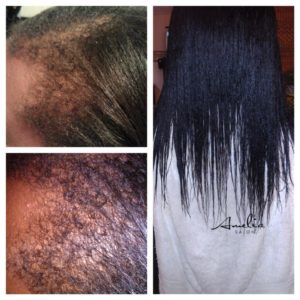 Pictured are two different women suffering from Postpartum Alopecia Hair Loss after their pregnancies on different areas of the head, (frontal and nape).
Pictured are two different women suffering from Postpartum Alopecia Hair Loss after their pregnancies on different areas of the head, (frontal and nape).
About 85 to 95 percent of the hair on your scalp is in the growing stage (Anagen Phase) and the other 5 to 15 percent is in a resting stage (Catogen Phase). After the resting stage, this hair sheds off (Telogen Phase), often while you’re combing, brushing, or shampooing it and is replaced by a new strand (back to the Anagen Phase). An average woman sheds about 50- 100 hairs a day.
What causes Postpartum Alopecia (Hair Loss)?
During pregnancy, increased levels of estrogen & progesterone lock the hair in the (Anagen Phase) growth stage, and in the (Catagen Phase) resting stage and less hair sheds out each day. So, you end up seeing more thicker and longer hair in most cases. However, in other cases some women lose their hair during pregnancy because of the increased levels of hormones. Then there are those that do not lose their hair at all.
When does this hair loss occur?
In most cases Hair loss occurs 3-6 months after the loss of a pregnancy or giving birth. Postpartum Hormone levels abruptly send hair into the Telogen Phase (shedding stage). (Also low levels of estrogen and oral- contraceptives can cause premature shedding and thinning). Sudden shedding is mainly seen in women with medium to long length hair. If the mother breastfeeds the baby some of the hair may stay on the scalp until she weans, starts to supplement with formula, or give solid foods. However, hair loss should be complete in a year and back to normal.
What You Can Do About It?
Keep your hair healthy by eating healthy (veggies, fruits and lean proteins) taking a prenatal vitamin supplement and drinking plenty of water. Be extra-gentle during your shedding stage to prevent unnecessary hair loss after pregnancy. Shampoo and deep condition once a week with a wide-toothed comb to minimize tangling. Use scrunchies, or clamps to put hair up, instead of rubber bands and styling the hair into tight ‘dos (i.e. braids) can be even more damaging. Skip blow dryers and thermal irons. Please do not use any chemically based treatments (highlights, perms, relaxers, straightening systems) until the shedding stops.
Talk to your Trichologist Practitioner or Cosmetologist if your hair loss is excessive. When it’s accompanied by other symptoms, hair loss after pregnancy could be a sign of postpartum thyroiditis.
